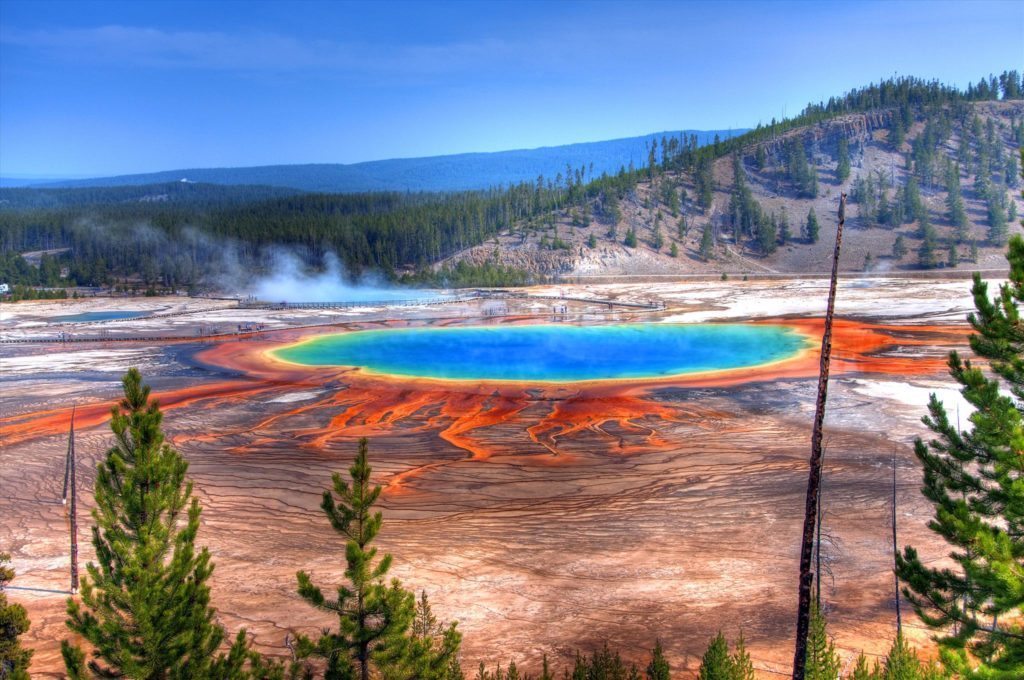4 reasons you need to visit Yellowstone National Park – America’s first national park, as written by our experienced staff! View our Yellowstone National Park holidays
Volcanos
Located on the continent’s largest active Supervolcano – the Yellowstone Caldera – Yellowstone National Park is a geological smoking gun that contains half of the world’s geothermal features, fueled by the ongoing volcanism of the area.
The Caldera has erupted several times in the last two million years, but is thought that the sudden explosion that took place 640,000 years ago is what made Yellowstone what it is today. What remains is just the smouldering caldera – a collapsed crater that is 45 by 30 miles The flowing lava, boiling hot springs, volcanic rock formations, geysers, mud spots and fumaroles are a constant reminder of the cataclysmic events that created this magnificent National Park. Don’t worry though – no eruption is expected in the immediate future!
Geysers
As mentioned above, the Yellowstone Caldera on which the National Park stands on is still very much active which leaves us with the beauty and enormity of over 450 fantastic geysers, such as the world renowned Old Faithful which erupts every 91 minutes. The Caldera also features some lesser known brothers; Castle Geyser, Lion Geyser and Beehive Geyser which are all located together in the Upper Geyser Basin. The park also contains the largest geyser in the world – Steamboat Geyser which throws water up higher than 300ft!
According to a recent study, 1283 geysers have erupted in Yellowstone National Park (more than anywhere else on earth) -which really gives the place that sort of post-apocalyptic feel!
Wildlife
Yellowstone National Park is encased by some absolutely stunning mountainous landscapes, and is home to an incredible abundance of wildlife which is practically unmatched across the continent.
Over 60 species of mammals call Yellowstone their home, including gray wolves, lynx, grizzly bears, black bears, bison, mountain goats, mountain lions and moose. There are also 10 different types of amphibians and reptiles living in the park along with 318 species of birds.
The fauna is of course one of the many draws of Yellowstone, and the reason for it’s profusion was almost a direct result of western America’s development and urbanisation. Yellowstone became America’s first national park in 1872, and the park now stands as a solace and refuge from the busy life that surrounds it. As a result, Yellowstone’s importance as a sanctuary for wildlife has just grown and grown since its inception.
Mountains and landscapes
The park sits at an average elevation of 8,000 feet above sea level and is bounded almost entirely by the Middle Rocky Mountains, which range from 9,000 to 11,000 feet with the highest peak – Eagle Peak – reaching 11,358 feet. Yellowstone also has one the world’s largest petrified forests, at least 290 waterfalls of at least 15 feet, and three deep canyons including the famous ‘Grand Canyon of the Yellowstone’ pictured below:
Yellowstone National Park offers everything; stunning landscapes, wildlife aplenty and a volcanic landscape that is pretty much unmatched across the globe. The park stands alone as a place of comfort and solace, somewhere to get away from the hustle and bustle of modern life, a place to experience nature in its own ecological habitat and somewhere to be at peace with the world.
Why not spend a morning taking in the explosiveness of the firehole basin, spend the afternoon sitting beside Yellowstone Lake with just the sound of birds singing over the tranquil silence. If you love the Natural World then you’ll never want to leave…
View our Yellowstone National Park holidays, enquire here or give us a call on 0115 9610590 to talk to the team!

Recent Comments